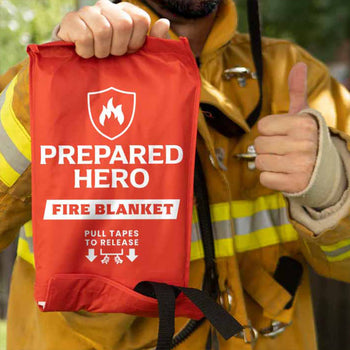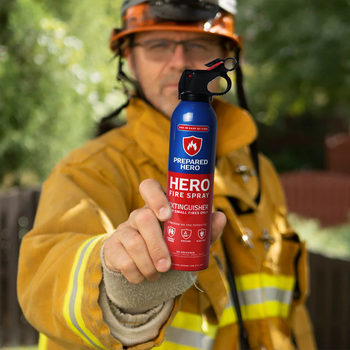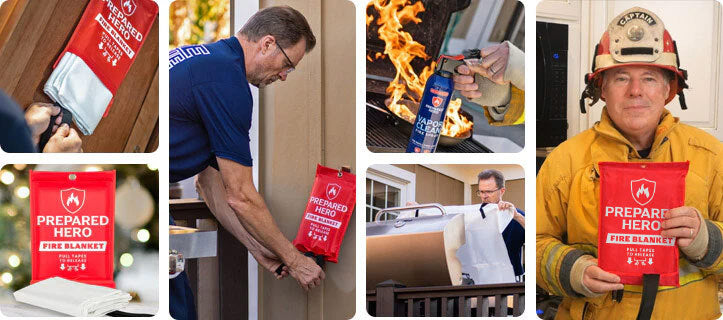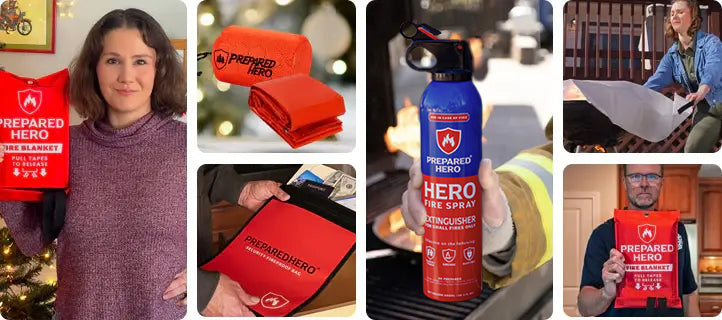Where you put your smoke detectors matters just as much as installing them. Proper placement makes sure they can detect...
An emergency action plan (EAP) helps people stay safe when things go wrong. It outlines how to prevent problems, prepare for emergencies, and respond when things go wrong. It clearly states what to do in different situations, from fires to earthquakes, so everyone knows what to do.
It also covers evacuation routes, meeting points, key contacts, and employee roles. Whether at home or work, having an EAP lets you act fast, protect lives, and reduce property damage.
But if you don’t know where to start, we’re here to help. In this guide, we‘ll talk about what to include in your EAP, who should be trained, and how to create one. We’ll also include an emergency action plan template, so you can make yours.
What Are the Five Components of an Emergency Action Plan?

An emergency action plan helps you handle emergencies safely. It outlines steps to prevent, prepare, and respond to emergencies while protecting lives and property. Here are the five components of an emergency action plan:
1. Prevention
Prevention is all about stopping emergencies before they happen. It includes spotting hazards early, having safety measures, and making rules to reduce the likelihood of accidents.
2. Mitigation
Mitigation helps minimize damage. This usually includes installing fire alarms, sprinklers, kitchen fire suppression systems, and having tools like fire blankets, fire sprays, and flame shields.
Do you want reliable, easy-to-use, and affordable tools to put out small fires before they spread? Check out Prepared Hero’s fire prevention tools here, and get up to 51% off on certain items.
3. Preparedness
This is where you plan ahead. It includes setting up communication systems, training your team on what to do, and preparing supplies (like a go bag or bug out bag) in case of an emergency.
4. Response
Being responsive means acting fast when an emergency occurs. This could mean evacuating, giving first aid, or working with emergency services to control the situation.
5. Recovery
Recovery helps get things back to normal after an emergency. This might involve repairs, support for those affected, and reviewing what happened to prevent similar issues in the future.
What Is the OSHA Standard for Emergency Action Plans?
The Occupational Safety and Health Administration’s (OSHA) standard for emergency action plans covers how to report fires or other emergencies, evacuation steps, and escape routes. It also assigns roles for rescue or medical personnel, and makes sure someone can answer questions about the plan.
According to the OSHA, a business with 10 or fewer employees can verbally explain the plan instead of writing it. Smaller workplaces can create a basic plan quickly, but larger ones or those with more risks need extra details to cover unique situations. For instance, a factory handling flammable and combustible items needs a fire prevention plan in writing.
What Are the 3 C’s of the Emergency Action Plan?

Knowing what to do in an emergency can save lives. Here are the 3 C’s of an emergency action plan:
1. Check
Look around and make sure the area is safe for you and others. Then, check the person for responsiveness and urgent issues like heavy bleeding or trouble breathing.
2. Call
Contact emergency services right away as soon as you’re done assessing the situation. Call 911 or your local fire department.
3. Care
Give basic first aid until professional help arrives. This usually includes stopping the bleeding, doing CPR if needed, and keeping the person calm.
What Are the 4 R’s of the Emergency Plan?

The 4 R’s of an emergency plan help you prepare, act, and recover during a crisis. Let’s break them down below.
1. Reduction
This is all about reducing risks. For instance, identify possible fire hazards and take steps to prevent or make them less harmful.
2. Readiness
Readiness is all about being prepared. That means creating a plan, training people, and making sure you have the tools and resources you’ll need during an emergency.
3. Response
This is what you do when an emergency happens. It focuses on protecting people, property, and the environment.
4. Recovery
Recovery means taking things back to normal once things are under control. It includes repairs, support for those affected, and reviewing how things went.
How to Make an Emergency Action Plan

Creating an emergency action plan isn’t just about meeting safety rules. It’s also about making sure everyone knows what to do when trouble hits. Here’s how to make an effective emergency action plan:
1. Start with the Basics
Your emergency action plan should be tailored to your workplace. Begin by listing potential emergencies like structure fires, chemical spills, earthquakes, and extreme weather.
2. Include Clear Reporting Steps
Explain exactly how to report an emergency. This could include calling 911, activating a fire alarm, or dialing an internal number. Make sure everyone knows these steps.
3. Map Out Evacuation Routes
Show the fastest ways out with floor diagrams. Mark workplace emergency exits, assembly points, and safety tool locations.
4. Assign Roles
Next, identify who shuts down equipment, checks rooms, and provides first aid. Make sure they’re trained and their tasks are safe. The RACE acronym is a great starting point for this.
5. Plan for Accountability
Have a system to account for everyone once they evacuate. Determine safe meeting spots and assign someone to do roll calls.
6. Train and Practice
Go over the plan with your team. Hold regular drills to make sure everyone remembers what to do.
7. Review and Update
Revisit your EAP regularly to keep contact info, exit routes, and evacuation procedures updated.
What Is an Example of an Emergency Action Plan?

An example of an emergency action plan is a workplace safety plan that covers how to report an emergency, where to evacuate, and where to meet afterward. It also clearly states who’s responsible for helping others and sharing updates. Plus, it makes sure everyone is accounted for. It’s clear, simple, and made for real situations.
What Is the Difference Between an ERP and a BCP?
An ERP (Emergency Response Plan) focuses on what to do during an incident. It covers steps like evacuation, lockdowns, and emergency communication. On the other hand, a BCP (Business Continuity Plan) involves what happens after. It focuses on recovery and getting operations back to normal. Both should be clear, practical, and easy to follow.
What Are the Minimum Requirements for an Emergency Action Plan?
The minimum requirements for an emergency action plan are clear reporting steps, evacuation routes, roles for critical tasks, accounting for everyone, rescue or medical duties, and key contact information.
How to Implement an Emergency Action Plan
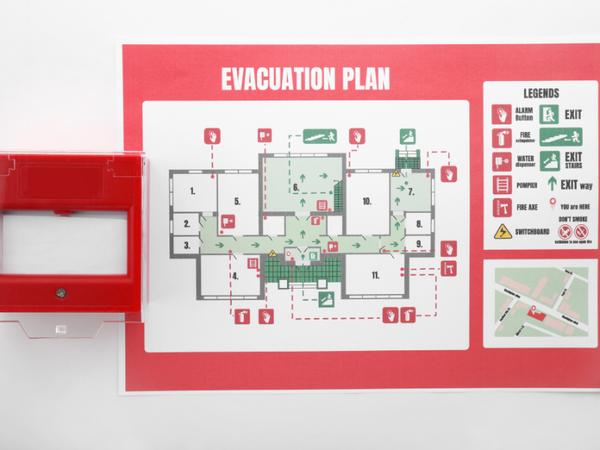
An emergency action plan will only work if you know how to implement it properly. Here’s how to do it:
1. Keep It Relevant
Match your plan to your workplace. A small office might only need a basic outline, while a site with hazardous materials needs more. Focus on the actual risks you face.
2. Make It Specific to Your Site
Every workplace is different. Include evacuation routes, meeting points, emergency contacts, and how to report problems based on your workplace’s layout and location. Keep the instructions clear and easy to follow.
3. Get the Team Involved
Ask employees for input. They may notice hazards or suggest improvements you’ve missed. Plus, people are more likely to follow a plan they helped create.
4. Assign Clear Roles
Choose a coordinator to take charge during emergencies. Identify who shuts down equipment, checks rooms, and provides first aid. Make sure everyone knows their job.
5. Train, Practice, and Review
Go over the plan with your team and hold drills so people know what to do. Review it regularly to update contacts, routes, or procedures.
Who Is Responsible for Emergency Action Plans?
Employers are responsible for emergency action plans. They should make it available to employees and explain it when someone is hired or assigned a new role.
Supervisors also play a key role. They have to make sure their subordinates understand the plan and know exactly what to do during an emergency. This includes knowing how to help coworkers who need extra assistance, like those with disabilities.
In addition, some workplaces have building emergency coordinators. They help manage building-wide emergency efforts and bridge departments and emergency services. They also make sure everyone’s on the same page before, during, and after an emergency.
Meanwhile, an incident commander takes charge when an emergency happens. They follow the EAP and make calls in real time. In some places, a safety liaison or emergency committee helps keep everything organized. Local fire departments may also give advice and support. So while it starts at the top, EAP responsibility is a team effort.
Emergency Action Plan Template
Facility Name: _____________________
Facility Address: ___________________
Date Prepared: ___ / ___ / _____
Key Contacts
- Responsible Official (Highest Manager)
Name ___________ | Phone ___________
- Emergency Coordinator
Name ___________ | Phone ___________
-
Area and Floor Monitors
Area/Floor: _______ | Name _____________ | Phone _______
Area/Floor: _______ | Name _____________ | Phone _______
-
Assistants for the Physically Challenged
Name _______ | Phone _______
Name _______ | Phone _______
Evacuation Information
- Evacuation maps are posted in work areas.
- Maps show exits, routes, fire extinguishers, alarm pull stations, and assembly points.
- Everyone should know at least two escape routes.
Emergency Numbers
-
Fire Department: ___________
-
Paramedics/Ambulance: ___________
-
Police: ___________
-
Security: ___________
-
Building Manager: ___________
Utilities
-
Electric: ___________ | Phone ___________
-
Water: ___________ | Phone ___________
-
Gas: ___________ | Phone ___________
-
Phone Company: ___________ | Phone ___________
What to Do in an Emergency
- Medical: Call emergency number, give details (what happened, location, your name/phone). Don’t move the victim unless necessary.
- Fire: Pull alarm, call the fire department, use extinguisher only if safe. Evacuate to the assembly area and wait for “all clear.”
- Power Outage: Turn off non-essential equipment, follow safety steps for freezing weather if needed.
- Chemical Spill: Notify coordinator, secure the area, wear PPE, follow safety data sheets.
- Severe Weather: Go to safe areas away from windows, follow the coordinator’s instructions.
Training
These people are trained to guide others during an evacuation:
Name __________ | Role __________ | Date __________
Name __________ | Role __________ | Date __________
Name __________ | Role __________ | Date __________
Conclusion
Having an emergency action plan isn’t just about checking a box. It’s about making sure everyone knows what to do when it matters most.
A solid plan prepares you for different scenarios, keeps people safe, and helps reduce damage. It should be clear, easy to follow, and practiced regularly so no one is caught off guard. Whether it’s for home, work, or both, taking the time to plan now can make all the difference when the unexpected happens. Stay prepared, hero!


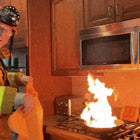 Fire
Fire Safety
Safety Survival
Survival Protection
Protection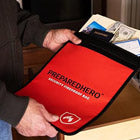 New
New
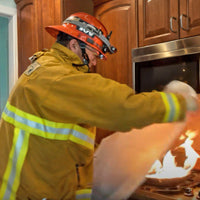 Fire
Fire Safety
Safety Survival
Survival Protection
Protection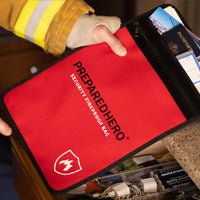 New
New
